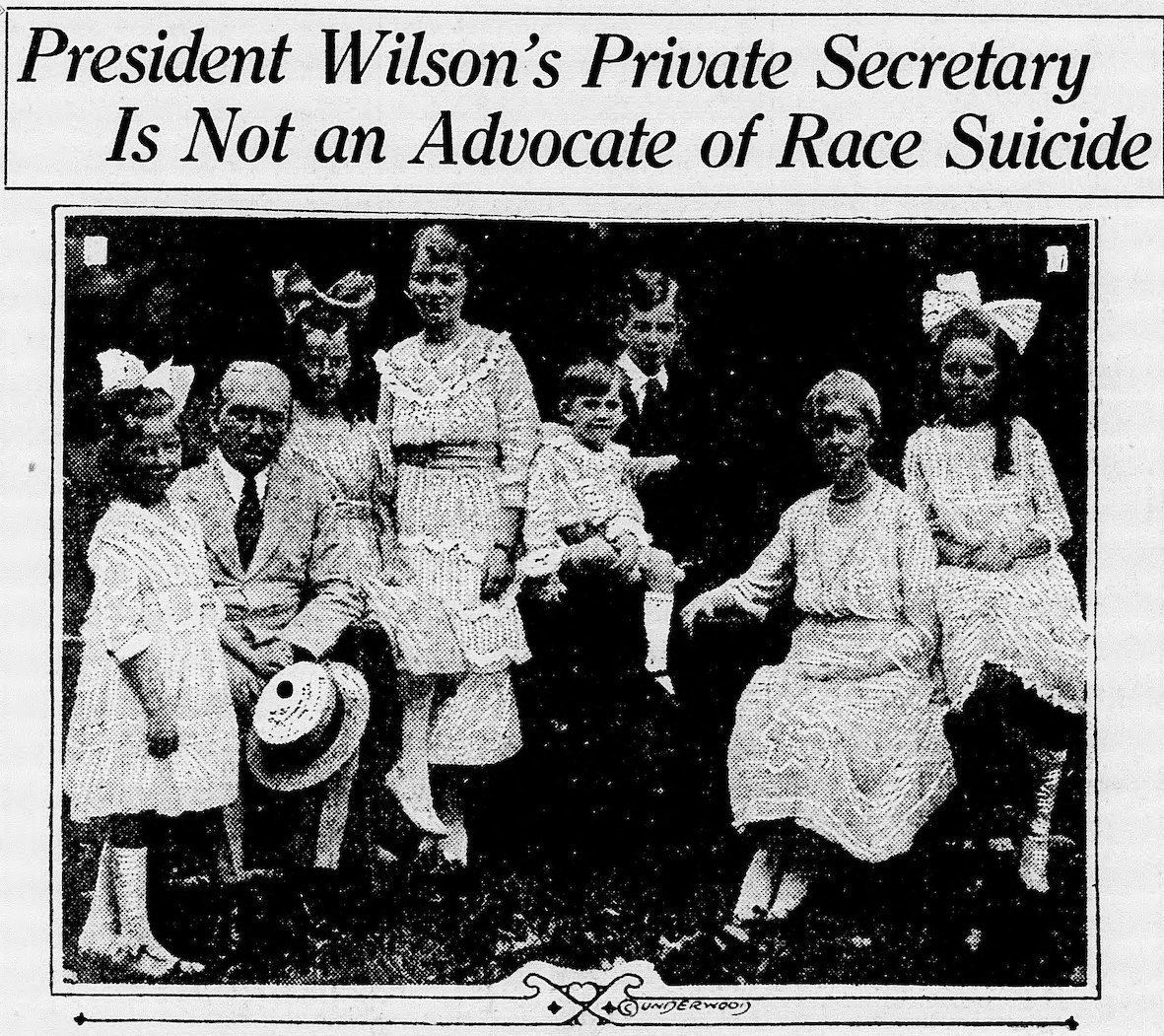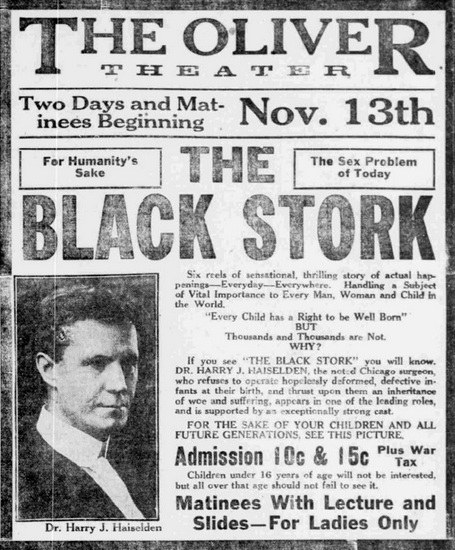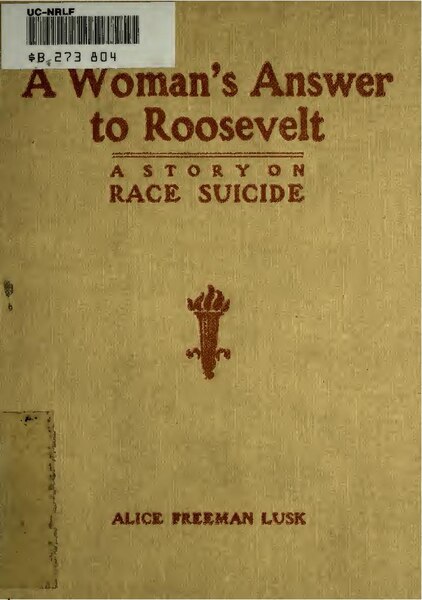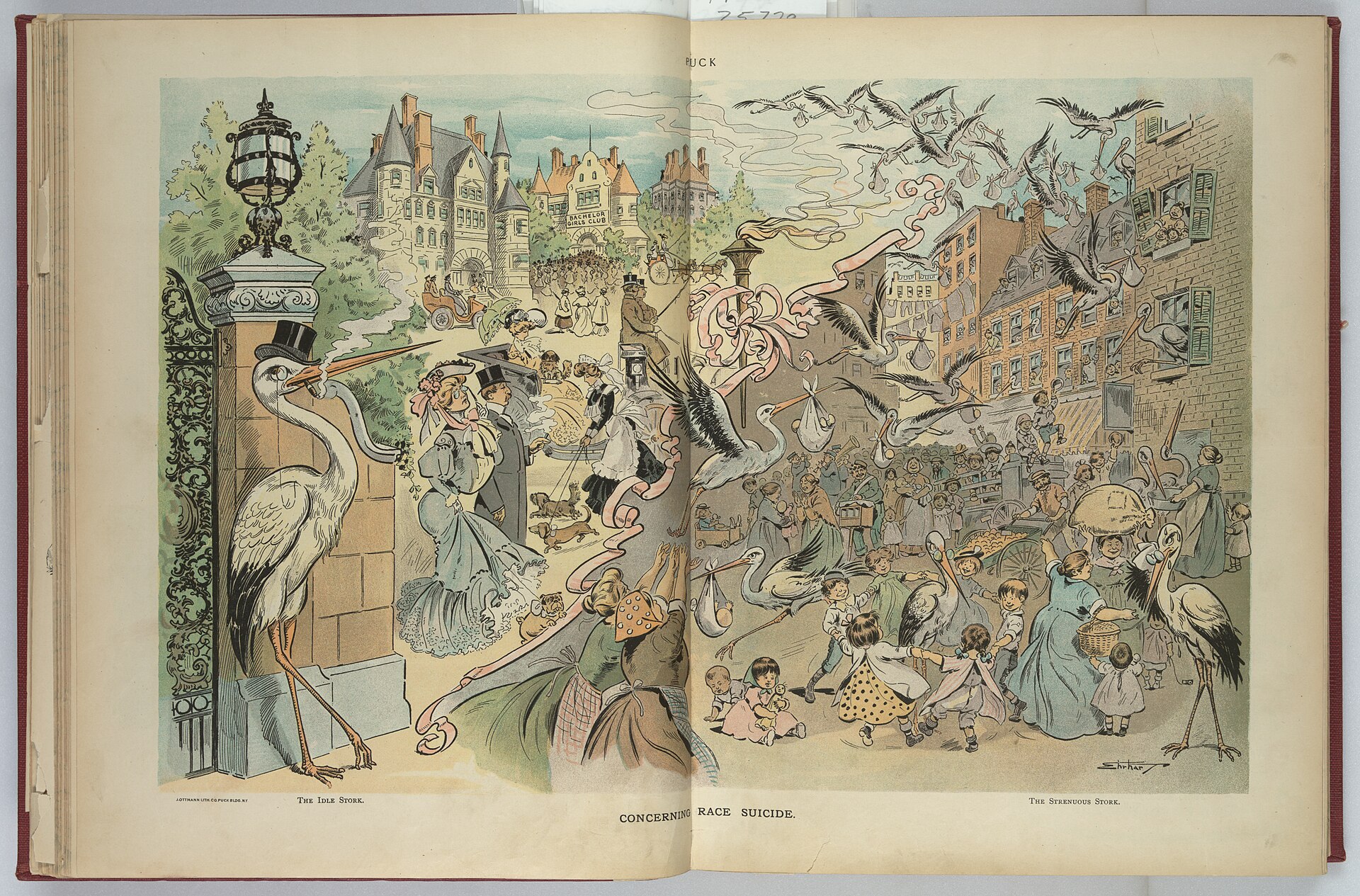
「人種の自滅」の概念
Race suicide as racism concept

A newspaper
photograph from 1919 of Joseph Patrick Tumulty with his
wife and six children, under the headline "President Wilson's Private
Secretary Is Not an Advocate of Race Suicide," from Great Falls
daily tribune. October 20, 1919
池田光穂
人種の自滅(レース・スーサイド)あるいは人種自殺 とは、異なった「人種」の混交(セックス)から生まれる「人種の純潔性」が汚れるという、白人の脅迫妄想から生まれた言葉。白人たちは、優生学がとりわけ 隆盛しはじめた時代(1900-1930)に、この概念をまず、自分たちの身の回りに起きている「人種の純潔性」が汚染されているという恐怖から、人種の みならず、民族のちがい、社会階層の違い、精神疾患や遺伝的疾患をもっている間の通婚を嫌ったり禁止したりした。当時は、植民地主義や帝国主義の時代でも あったので、ヨーロッパの支配民族が統治する非ヨーロッパの植民地における人種管理や民族の統治の概念として「転用」し、異民族間の結婚や通婚を(禁止を 含む)管理するという、人種管理政策をおこなった。
***
| Race suicide was
an alarmist eugenicist theory, coined by American
sociologist Edward A. Ross around 1900 and promoted by, among others,
Harry J. Haiselden.[1] According to the American Eugenics Archive,
"race suicide" conceptualizes a hypothetical situation in which the
death rate of a particular "race" supersedes its birth rate.[2] As a propagandistic theory akin to white genocide, race suicide was mechanized to induce fear in dominant and/or majority "races" (i.e. the "white race") that their community was dying off and being replaced by more fertile immigrant "races". This term was likewise deployed to proliferate the ideology of Eugenics among the international public throughout the 20th century.[2] Moreover, the concept of "race suicide" predominantly placed blame on women, as supposed agents of reproduction. With its roots in Nordicism, the application of this alarmist theory varied based on the targeted community and/or country.[3] |
人種自殺は、1900年頃にアメリカの社会学者エドワード・A・ロスが
作り出した、人種改良論者の誇張した理論であり、ハリー・J・ヘイズデルデン
(Harry J. Haiselden)などによって推進された。[1]
アメリカ優生学アーカイブによると、「人種自殺」とは、特定の「人種」の死亡率が出生率を上回るという仮説上の状況を概念化したものである。[2] 白人による大量虐殺に類似したプロパガンダ理論として、人種自殺は、支配的および/または多数派の人種(すなわち「白人」)に、自分たちのコミュニティが 衰退し、より繁殖力の高い移民の人種に置き換えられていくという恐怖を植え付けるために利用された。この用語は、20世紀を通じて国際社会一般に優生学の イデオロギーを広めるためにも使用された。[2] さらに、「人種自殺」という概念は、主に生殖の担い手である女性に責任を押し付けるものであった。北欧主義にその起源を持つこの誇張された理論の適用は、 標的とされたコミュニティや国によって異なっていた。[3] |
| 《old article》 Race suicide was an alarmist term used in eugenics, coined in 1900 by the sociologist Edward A. Ross.[1][2] Racial suicide rhetoric suggested a differential birth rate between native-born Protestant and immigrant Catholic women, or more generally between the "fit" or "best" (white, wealthy, educated Protestants), and the "unfit" or "undesirable" (poor, uneducated, criminals, diseased, mental and physical "defectives," and ethnic, racial, and religious minorities),[3] such that the "fit" group would ultimately dwindle to the point of extinction.[4][5] Belief in race suicide is an element of Nordicism.[6] In anti-East Asian discourse, the concept is associated with the "Yellow Peril."[6][7] In 1902, US President Theodore Roosevelt called race suicide "fundamentally infinitely more important than any other question in this country" and argued that "the man or woman who deliberately avoids marriage, and has a heart so cold as to know no passion and a brain so shallow and selfish as to dislike having children, is in effect a criminal against the race, and should be an object of contemptuous abhorrence by all healthy people."[8] Likewise, in 1905, he argued that a man or woman who is childless by choice "merits contempt."[9] In Canada, the idea of race suicide was espoused by W. Stewart Wallace, the author of "The Canadian Immigration Policy," which cited the native-born population's "struggle to keep up appearances in the face of the increasing competition" as a purported cause of its low birth rate. Wallace claimed that immigrants did not increase a nation's population but merely replaced it.[10] |
《旧版の記述》 人種の自滅(人種の自殺)は、1900年に社会学者エドワード・A・ロ スによって作られた優生学で使用される憂慮すべき用語である[1][2]。人種的自殺のレトリックは、ネイティブ・プロテスタントと移民のカトリック女性 の間の、あるいはより一般的には「適合」または「最良」(白人、裕福、教育を受けたプロテスタント)と「不適合」または「望ましくない」(貧困、無教育、 犯罪者、病気、心身の「欠陥」、民族・人種・宗教的少数派)、つまり「適合」グループが最終的に絶滅するほど減少するであろうという出生率の差異を示唆し た [3]. [東アジアの民を排除する言説としては、この概念は「黄禍」と関連付けられている[6][7]。 1902年、アメリカ大統領セオドア・ルーズベルトは人種の自滅を「この国の他のどの問題よりも根本的に限りなく重要」だと呼び、「意図的に結婚を避け、 情熱を知らないほど冷たい心を持ち、子供を持つことを嫌うほど浅薄で利己的な脳を持っている男や女は、事実上民族に対する犯罪者で、すべての健常者が軽蔑 し嫌悪の対象とすべき」と論じた[8] 。 「同様に1905年には、選択によって子供を持たない男女は「軽蔑に値する」と論じている[9]。 カナダでは、「カナダ移民政策」の著者であるW・スチュワート・ウォレスによって人種の自殺の考えが支持され、出生率の低さの原因とされるものとして、生 まれながらの人口の「競争の激化に直面して体裁を保つための苦闘」を挙げている。ウォレスは、移民は国の人口を増やすのではなく、単に人口を置き換えるだ けであると主張した[10]。 |
A newspaper photograph from 1919
of Joseph Patrick Tumulty with his
wife and six children, under the headline "President Wilson's Private
Secretary Is Not an Advocate of Race Suicide," from Great Falls
daily tribune. October 20, 1919 |
1919年の新聞記事の写真には、妻と6人の子供たちとともに写るジョ
セフ・パトリック・トゥマルティが、「ウィルソン大統領の個人秘書は人種自殺の擁護者ではない」という見出しとともに掲載されている。Great
Falls daily tribune紙、1919年10月20日 |
| Eugenics Main article: Eugenics The theory of race suicide is fundamentally rooted in and influenced by the internationally popularized and pseudoscientific theory of Eugenics, which advocates for the universal improvement of the human gene pool through the elimination of certain "races" deemed "unfit" for reproduction.[4] In the United States, "unfit" races have historically included minorities such as immigrants and African Americans, people with mental and physical disabilities, people in poverty, institutionalized people, and/or people convicted of crimes. Eugenics sought to eliminate these people, such that their "undesirable traits and behaviors" would be effectively weeded out of the human population over time.[4] Race suicide rhetoric induced fear in dominant groups and institutions by eliciting Eugenics and suggesting that these "undesirable" and "unfit" racial groups were proliferating, while the "desirable" and "fit" racial groups were essentially "killing themselves" by failing to sufficiently reproduce.[5] As a result of fear-mongering, race suicide theorists in the 20th century turned to socio-political institutions, pseudoscientific propaganda, and social policy.[6] They believed that such policies would supposedly prevent race suicide before the "unfit" racial groups replaced the "fit" ones. In doing so, they gave rise the theory of Eugenics.[5][6] In this age of international eugenic propaganda, "Race suicide theorists believed that natural evolutionary dynamics were disrupted in the age of industry, and that social policy was needed to ensure that the supposedly superior 'races' did not disappear."[2] This propaganda ran throughout newspapers and educational spaces. This eugenic propaganda also contributed to conversations pertaining to forced sterilization of the "unfit", "hypersexual", and those with "hereditary defectiveness".[7] For example, S. Fred Hogue first released his weekly pro-eugenics column in the Los Angeles Times Sunday Magazine in 1935. In one column entitled "Shall We Halt Race Suicide", he wrote: "It is self-evident that if the unfit are to be permitted to reproduce at the present alarming rate, they will wreck civilization ... To prevent this form of race suicide, it is absolutely essential that the unfit shall not be permitted to continue to reproduce their kind."[7] |
優生学 詳細は「優生学」を参照 人種自殺論は、国際的に広まった疑似科学である優生学の理論に根本的に根ざしており、影響を受けている。優生学は、生殖に「不適当」とみなされた特定の 「人種」を排除することで、人類の遺伝子プールの全体的な改善を提唱するものである。[4] 米国では、歴史的に「不適当」な人種には、移民やアフリカ系アメリカ人などのマイノリティ、精神および身体障害者、貧困層、施設収容者、および/または犯 罪歴のある人々が含まれてきた。優生学は、これらの人々を排除しようとし、その「望ましくない特徴や行動」が、長い時間をかけて人類から効果的に淘汰され ることを目指した。 人種自殺論は、優生学を想起させ、これらの「望ましくない」人種集団や「不適格」な人種集団が増殖している一方で、「望ましい」人種集団や「適合」する人 種集団は、十分に繁殖しないことで本質的に「自滅」していると示唆することで、支配的なグループや機関に恐怖を煽った。 [5] 恐怖をあおる結果、20世紀の人種自殺論者は社会政治制度、疑似科学的なプロパガンダ、社会政策に目を向けた。[6] 彼らは、そのような政策が「適合」の人種が「不適合」の人種に取って代わられる前に人種自殺を防ぐはずだと信じていた。そうすることで、優生学の理論が生 まれた。[5][6] 国際的な優生学の宣伝が盛んに行われたこの時代において、「人種自殺論者たちは、自然の進化の力学は産業革命の時代に混乱し、優れているはずの「人種」が 消滅しないように社会政策が必要だと考えていた」[2]。この宣伝は新聞や教育の場を通じて広まった。優生学の宣伝は、「不適格者」、「性欲過多者」、お よび「遺伝的欠陥者」に対する強制不妊手術に関する議論にも影響を与えた。[7] 例えば、S. フレッド・ホーグは1935年に、ロサンゼルス・タイムズ・サンデー・マガジンで、優生学を支持するコラムを毎週掲載し始めた。「人種自殺を阻止すべき か」と題されたコラムで、彼は次のように書いた。「明らかに、不適格者が現在の驚くべき速さで繁殖することを許されるのであれば、彼らは文明を破壊するこ とになるだろう。... この人種自殺の形態を防ぐためには、不適格者がその種を繁殖し続けることを許さないことが絶対に不可欠である。」[7] |
| Racialized women Hypersexualization of women of color The first element to disentangling "race suicide" and the racialization of women of color is hypersexualization. Hypersexualization is an objectifying portrayal of people, most often women, usually of color, as excessively sexual. The objectification was instrumental in perpetuating concerns of race suicide because many people assumed women of color were reproducing at higher rates and seducing white men, therefore reducing the white race's size – a pseudoscientific "fact" with no basis in truth.[8] Immigration The hypersexualization of women of color was not only socially perpetuated but was systemically ingrained into U.S. institutions. For instance, the first immigration legislation that set the parameters for who could enter the country was the Page Act of 1875.[9] This law barred Chinese women from migrating to the U.S. out of fear that they were immoral and diseased prostitutes.[9] The 1924 Johnson-Reed Act, which was passed partly to "combat the specter race suicide",[10]: 352 brought this to an extreme by banning all Asian Americans. More broadly, the Act engaged in a racialized operation of tightening the borders by setting national quotas for immigrants. This "hardened anti-Black racism and turned Asians and Latino/as into immutable others".[10]: 353 To help pass such laws, influential scientific figures like Harry H. Laughlin testified before Congress, warning of a race suicide if such dynamics, partly based on an assumption of hypersexuality, prevailed and immigration law failed to be strong enough.[10]: 357 Incarceration Incarceration institutions perpetuated ideas of hypersexuality. Jails imprisoned women for deviating from norms of sexuality. Black people, especially during the Jim Crow era, were sent to prisons at disproportionate rates.[11] When these women of color were incarcerated, they were not sent to reformatories like white women, but rather, they resided in custodial prisons like men.[11] |
人種化された女性 有色人種の女性に対する過剰な性的描写 「人種的自殺」と有色人種の女性に対する人種化を解明する最初の要素は、過剰な性的描写である。過剰な性的描写とは、通常有色人種の女性を過度に性的であ るかのように描く、人々を客観視する描写である。この客観視は、人種的自殺への懸念を永続させるのに一役買っていた。なぜなら、多くの人々は有色人種の女 性がより高い割合で子孫を残し、白人男性を誘惑していると想定し、その結果、白人種の人口が減少していると信じていたからだ。これは真実に基づく根拠のな い疑似科学的な「事実」である。[8] 移民 有色人種の女性の過剰な性的描写は、社会的に永続化されただけでなく、米国の制度に体系的に根付いていた。例えば、米国への入国を許可する条件を定めた最 初の移民法は、1875年のページ法であった。[9] この法律は、中国人女性が不道徳で病気持ちの売春婦であるという懸念から、米国への移住を禁止した。[9] 1924年に可決されたジョンソン=リード法は、一部には「人種による自殺の恐怖に対抗する」ことを目的としていたが、[10]: 352 極端な例として、アジア系アメリカ人全員を禁止した。さらに広く言えば、この法律は移民の国民別割当数を定めることで国境を強化するという人種主義的な政 策を展開した。この法律は「黒人に対する根強い人種主義を強化し、アジア人とラテン系の人々を不変の他者へと変えた」のである。[10]: 353 このような法律の成立を後押しするために、ハリー・H・ラフリンのような影響力のある科学者が議会で証言し、過剰性欲という前提に基づいた部分もあるこの ような力学が蔓延し、移民法が十分に強力でない場合、人種的自殺が起こる可能性があると警告した。[10]: 357 収監 収監施設は、性的倒錯の考えを永続させた。刑務所は、性的規範から逸脱した女性を投獄した。特にジム・クロウ法の時代には、黒人が不当に高い割合で刑務所 に送られていた。[11]有色人種の女性が収監された場合、白人女性のように感化院に送られることはなく、むしろ男性と同じ拘置所に収容された。[11] |
Legal and cultural influence A promotional flyer for The Black Stork Case law provides additional evidence for hypersexual racialization and race suicide anxieties. Rhinelander v. Rhinelander (1925), for instance, painted a Black woman as a hypersexual "vamp" who took advantage of her white husband.[12] The white man, Leo Rhinelander, claimed that his wife lied about her ancestry. The trial lawyers portrayed Alice Jones as a "sexually aggressive woman who seduced the younger Leo Rhinelander".[12]: 167 This is the image of a "vamp", which is a woman who seduces men, most often applied specifically to women of color.[12] The case echoed societal fears of race corruption, specifically that white men's relations with hypersexual black women could inevitably contribute to "'race suicide' or the demise of the white race".[12]: 170 On the cultural side, films like The Black Stork crafted images of seductive enslaved women,[13] while the Dragon Lady and Lotus Blossom cinematic stereotypes villainized Asian American women as temptresses.[9] Institutional and cultural mechanisms in the U.S. worked in tandem to promote the image of women of color as hypersexualized and thus threatening to the survival of the white race. |
法的および文化的影響 「The Black Stork」の宣伝用チラシ 判例法は、性的な人種化や人種的自殺への不安を裏付けるさらなる証拠を提供している。例えば、Rhinelander v. Rhinelander(1925年)では、黒人女性が白人男性を食い物にする性的倒錯者「ヴァンプ」として描かれている。[12] 白人男性のレオ・ラインランダーは、妻が自分の家系について嘘をついていると主張した。 裁判弁護士たちは、アリス・ジョーンズを「若いレオ・ラインランダーを誘惑した性的に攻撃的な女性」として描いた。[12]: 167 これは「ヴァンプ」というイメージであり、これは男性を誘惑する女性を指し、特に有色人女性に対して用いられることが多い。[12] この訴訟は、人種間の腐敗に対する社会的な不安を反映しており、特に白人男性と性的な黒人女性との関係は、「人種の自滅」すなわち「白人の絶滅」に必然的 に寄与する可能性があるというものであった。[12]: 170 文化面では、『ブラック・ストーク』のような映画が、魅惑的な奴隷の女性像を作り上げた[13]。一方、『ドラゴン・レディ』や『ロータス・ブロッサム』 といった映画のステレオタイプは、アジア系アメリカ人女性を誘惑する悪女として描いた[9]。米国の制度と文化のメカニズムは、有色人種の女性を性的に過 剰刺激する存在として描き、白人種の存続を脅かす存在として宣伝するべく、同時に機能していた。 |
| Hysteria Main article: Hysteria A common diagnosis in the earlier twentieth century dubbed "hysteria" also played a role in the racialization of women and, in turn, racial suicide fears. Hysteria was an illness apparently plaguing white, upper-class women.[14] The sickness purportedly caused (white) women to be frail, weak, and not reproduce, which endangered the longevity of the white race.[14] Hysteria played into racializing dynamics largely because the chief cause was the "overcivilization" of white women, which was put in a binary opposition to hardy "savages" – a category for women of color.[14] Examples of this dynamic are evident in the American Journal of Obstetrics during the 1880s. For instance, George J. Engelmann[14] published several articles that concluded these "primitive" (Black, Mexican, Native American, Asian American, poor Appalachian white) and "savage" women experienced labor as "short and easy", compared to overcivilized white women.[15] Joseph Johnson gathered similar observations, specifically on enslaved women, noting that there were "surprisingly few preternatural or instrumental cases [forceps deliveries] among them".[16] Doctor Lucien Warner explicitly tied race and gender when he explicated that Black women and other immigrants were robust workers who had "comparative immunity from uterine disease" relative to white women.[17] Overall, George Beard best summarized these dynamics in 1881 when explicitly surmised, "nervous disease scarcely exists among savages or barbarians, or semi-barbarians or partially civilized people".[18] The categorization and diagnosis of hysteria were founded in societal and "scientific" ideas that women of color, savage women, were robust, strong, fertile, and threatening – partly related to their hypersexuality, as many evolutionary theories pointed to hypersexuality as a sign of being uncivilized,[19] and partly related to their innate "savagery". Upper-class white women were weak, fragile, nervous, and infertile. These dynamics, where women of color were fertile and birthing while hysterical white women were not, inevitably exacerbated race suicide concerns.[14]: 266 |
ヒステリー 詳細は「ヒステリー」を参照 20世紀初頭に「ヒステリー」と呼ばれた一般的な診断も、女性の「人種化」と、ひいては人種的な自殺の恐れという役割を果たした。ヒステリーは、白人上流 階級の女性を悩ませる病気であると思われていた。[14] この病気は、白人女性を虚弱で弱く、生殖不能にし、白人種の存続を危うくする原因となると考えられていた。[14] ヒステリーが人種化の力学に影響を与えた主な原因は、白人女性の「文明化の行き過ぎ」であり、それはたくましい「野蛮人」という二項対立のカテゴリーに置 かれた有色人種の女性たちであった。この力学の例は、1880年代の『アメリカ産科ジャーナル』誌に明白に示されている。例えば、ジョージ・J・ エングルマン[14]は、これらの「未開人」(黒人、メキシコ人、ネイティブアメリカン、アジア系アメリカ人、貧しいアパラチア地方の白人)や「野蛮人」 の女性たちは、文明化されすぎた白人女性と比較すると、陣痛は「短く楽」であると結論づけた複数の記事を発表した。[15] ジョセフ・ジョンソンは、特に奴隷の女性に関する同様の観察結果を集め、「彼女たちの間では、超自然的なケースや器具を使用したケース(鉗子分娩)は驚く ほど少ない」と指摘した。 [16] ルシアン・ワーナー医師は、黒人女性やその他の移民は白人女性と比較して「子宮の病気に対する相対的な免疫」を持つたくましい労働者であると説明し、人種 と性別を明確に関連付けた。[17] 全体として、ジョージ・ビアードは1881年にこれらの力学を最もよく要約し、次のように明確に推測した。「神経症は、未開人や野蛮人、あるいは半野蛮人 や部分的に文明化された人々にはほとんど存在しない」[18] ヒステリーの分類と診断は、有色人種の女性、野蛮な女性は、たくましく、強く、繁殖力があり、脅威的であるという社会的な「科学的」な考えに基づいてい た。これは、多くの進化論が、過剰な性欲を未開の兆候として指摘していたことと関連しており、また、彼女たちの生まれながらの「野蛮性」とも関連してい た。上流階級の白人女性は、虚弱で神経質、不妊であった。有色人種の女性が繁殖力があり出産している一方で、ヒステリーを起こした白人女性はそうでないと いうこの力学は、人種自殺への懸念を必然的に悪化させた。[14]: 266 |
| Language and political
implications Race suicide rhetoric in the U.S. Early race suicide rhetoric in the United States suggested a differential birth rate between native-born Protestant and immigrant Catholic women, or more generally between the "fit" (white, wealthy, educated Protestants) and the "unfit" (poor, uneducated, criminals, diseased, disabled, minorities). Fear-mongering tactics relied on the idea that the "fit" group would ultimately dwindle to the point of extinction if they did not adopt an urgency to reproduce. This rhetoric was later extended to further entrench the eugenic claim that African Americans and other immigrants "races" with growing populations were "unfit," "hypersexual," and "dangerous."[20] In 1902, Theodore Roosevelt, the President of the United States, called race suicide "fundamentally infinitely more important than any other question in this country," arguing to the American public that "the man or woman who deliberately avoids marriage, and has a heart so cold as to know no passion and a brain so shallow and selfish as to dislike having children, is in effect a criminal against the race, and should be an object of contemptuous abhorrence by all healthy people." Likewise, in 1905, he argued that a man or woman who is childless by choice "merits contempt."[21][22]  This 1908 book by Alice Freeman Lusk challenged and pushed back against Theodore Roosevelt and society's traditional gender roles for women. This political agenda further targeted women and criticized them for choosing not to fulfill their "duty" of getting married and having children and thus maintaining the White population. In contrast, the growing non-White population was overly exaggerated in order to frame the situation as an alarming matter.[23] Many newspaper articles claimed that this great increase was a threat that these non-White groups would have greater participation and more of an influence in politics in the future.[24] In contrast, women who left a "legacy" after their death by having numerous children, and subsequently, grandchildren and great-grandchildren, were openly praised for helping to "fight against" the idea of race suicide.[25] |
言語と政治的な含み 米国における人種自殺のレトリック 米国における初期の人種自殺のレトリックでは、土着のプロテスタント女性と移民のカトリック女性の間、あるいはより一般的に「適合者」(白人、富裕層、高 学歴のプロテスタント)と「不適合者」(貧困層、低学歴、犯罪者、病人、障害者、少数民族)の間で出生率に差があることが示唆されていた。恐怖をあおる戦 術は、「適者」グループが生殖に急を要する状況を受け入れない限り、最終的には絶滅の危機に瀕するという考えに基づいている。この暴論は後にさらに拡大さ れ、アフリカ系アメリカ人やその他の人口増加中の「人種」は「不適格」、「性欲過多」、「危険」であるという優生学的主張をさらに強固なものにした。 [20] 1902年には、米国大統領セオドア・ルーズベルトが人種自殺を「この国における他のいかなる問題よりも根本的に無限に重要な問題」と呼び、 「結婚を意図的に避け、情熱を知らず、子供を持つことを嫌うほど浅はかで利己的な心を持つ男性や女性は、事実上、人種に対する犯罪者であり、健全な人々す べてから軽蔑と嫌悪の対象となるべきである」とアメリカ国民に主張した。同様に、1905年には、意図的に子供を持たない男女は「軽蔑に値する」と主張し た。[21][22]  1908年に出版されたアリス・フリーマン・ラスクの著書は、セオドア・ルーズベルトや社会の伝統的な女性に対する性別役割分担に異議を唱え、反発した。 この政治的アジェンダはさらに女性を標的にし、結婚して子供を産み、白人人口を維持するという「義務」を果たさないことを批判した。それとは対照的に、白 人以外の人口増加は、事態を憂慮すべき問題として描くために、過度に誇張された。 [23] 多くの新聞記事は、この大幅な増加は、非白人グループが今後、政治への参加と影響力を強めるという脅威であると主張した。[24] 一方で、多数の子供をもうけ、その子供たちや孫たちが生まれることで「遺産」を残した女性たちは、人種自殺という考えに「抵抗する」手助けをしたとして、 公然と称賛された。[25] |
| Media and culture As the teddy bear, which was named after Theodore Roosevelt, increased in popularity, some individuals were worried that young girls who did not play with dolls as often would lose their "motherly instincts". Criticism of the teddy bear was another form of fear mongering, as these people claimed it contributed to the concept of race suicide.[26] In response to Theodore Roosevelt's public warning against the idea of race suicide, some individuals also extended this concept, suggesting restrictions not only on non-White races, but also to individuals in lower economic classes due to "economic and educational reasons".[27] It was no longer only political figures, but also ministers, educators, and other individuals in leadership positions who were pushing for legislation to encourage White Americans to marry and have children.[28] For example, Alexander Graham Bell publicly expressed his support for this agenda.[29] The 1938 movie Race Suicide criticized women who chose not to get married or have children, with the line "Are Modern Women Cheaters?" standing out in its movie poster.[30]  An illustration by Ehrhart showing storks contributing to or working against race suicide (1903). Many propaganda images were also created and distributed through avenues, such as newspapers. A popular symbol that was used was the stork, a bird often associated with the idea of "bringing babies". One example is an illustration from 1903 created by Samuel D. Ehrhart, which is displayed to the right. It depicted an "idle" stork of the upper class not fulfilling its duty, while the "strenuous" stork of the lower class was constantly working and increasing that population.[31] |
メディアと文化 セオドア・ルーズベルトにちなんで名付けられたテディベアの人気が高まるにつれ、人形遊びをあまりしない若い女性たちが「母性本能」を失うのではないかと 心配する声もあった。テディベアに対する批判は、人種自殺という概念を助長するものだという主張であり、これもまた恐怖をあおる行為であった。 セオドア・ルーズベルトが人種自殺という考えに対する公の警告を発したことに対して、一部の個人もこの概念を拡大し、「経済的および教育的な理由」から、 非白人種だけでなく経済的階級の低い個人にも制限を課すべきだと主張した。 [27] 政治家のほか、聖職者、教育者、その他の指導的立場にある人々も、白人のアメリカ人に対して結婚と出産を奨励する法律の制定を推進するようになった。 [28] 例えば、アレクサンダー・グラハム・ベルは、この方針への支持を公に表明した。[29] 1938年の映画『人種的自殺』は、結婚や出産を望まない女性を批判し、映画のポスターには「現代の女性は浮気者?」というキャッチコピーが目立ってい た。  人種的自殺に貢献または逆行するコウノトリを描いたエーハートのイラスト(1903年)。 多くのプロパガンダ画像も新聞などの媒体を通じて作成・配布された。よく使われたシンボルは「赤ちゃんを運んでくる」というイメージと関連付けられること の多いコウノトリであった。その一例が、右側に掲載されているサミュエル・D・エーハートが1903年に描いたイラストである。このイラストでは、義務を 果たさない上流階級の「怠惰な」コウノトリと、常に働き続け人口を増やしている下層階級の「勤勉な」コウノトリが描かれている。[31] |
| Race suicide rhetoric in Canada Similarly in Canada, W. Stewart Wallace, the author of "The Canadian Immigration Policy," endorsed the idea of race suicide. "The Canadian Immigration Policy" cited the native-born population's "struggle to keep up appearances in the face of the increasing competition" as a purported cause of its low birth rate. Wallace claimed that immigrants did not increase a nation's population but merely replaced it.[32] |
カナダにおける人種自殺論調 同様にカナダでは、『カナダ移民政策』の著者であるW・スチュワート・ウォレスが人種自殺の考えを支持した。『カナダ移民政策』は、出生率の低さの原因と して、出生地カナダの人口が「競争の激化に直面しながら体裁を保とうと奮闘している」ことを挙げた。ウォレスは、移民は国民の人口を増やすのではなく、単 に人口を入れ替えているだけだと主張した。[32] |
| Great
Replacement conspiracy theory, a later theory with similar themes Natalism, promoting higher fertility rates |
偉大な代替陰謀論、同様のテーマを持つ後発の理論 ナタリズム、出生率の向上を推進する |
| Further reading Gordon, Linda (2002). "Race Suicide". The Moral Property of Women: A History of Birth Control Politics in America. University of Illinois Press. pp. 86–104. ISBN 978-0-252-09527-6. JSTOR 10.5406/j.ctt3fh3j5. Leonard, Thomas C. (November 2005). "Retrospectives: Eugenics and Economics in the Progressive Era" (PDF). Journal of Economic Perspectives. 19 (4): 207–224. doi:10.1257/089533005775196642. King, Miriam; Ruggles, Steven (Winter 1990). "American Immigration, Fertility, and Race Suicide at the Turn of the Century". Journal of Interdisciplinary History. 20 (3): 347–369. doi:10.2307/204082. JSTOR 204082. PMID 11617376. MacNamara, Trent (2018). "Race Suicide". Birth Control and American Modernity: A History of Popular Ideas. pp. 37–64. doi:10.1017/9781108650465.002. ISBN 9781108650465.</ref> "What is race suicide?". Times of India. 2004-09-26. Retrieved 2019-08-16. |
さらに読む ゴードン、リンダ(2002年)。「人種的自殺」。『女性の道徳的財産:アメリカにおける出生制御政治の歴史』。イリノイ大学出版。86-104ページ。 ISBN 978-0-252-09527-6。 JSTOR 10.5406/j.ctt3fh3j5. レナード、トーマス・C. (2005年11月). 「回顧:進歩主義時代における優生学と経済学」(PDF)。『経済展望ジャーナル』19 (4): 207–224. doi:10.1257/089533005775196642. キング、ミリアム、スティーブン・ラグルズ(1990年冬)。「アメリカへの移民、出生率、そして世紀転換期の人種自殺」。学際的歴史ジャーナル。20 (3):347-369。doi:10.2307/204082。 JSTOR 204082。PMID 11617376。 マクナマラ、トレント(2018年)。「人種的自殺」。『避妊とアメリカの近代性:大衆の考え方の歴史』。37-64ページ。doi: 10.1017/9781108650465.002。ISBN 9781108650465。</ref> 「人種自殺とは何か?」タイムズ・オブ・インディア。2004年9月26日。2019年8月16日取得。 |
| https://en.wikipedia.org/wiki/Race_suicide |
***
+++
Links
リンク
文献
その他の情報
Copyleft, CC, Mitzub'ixi Quq Chi'j, 1996-2099
☆
 ☆
☆